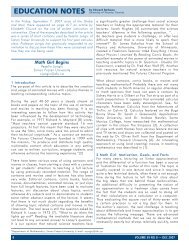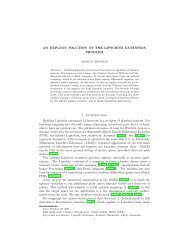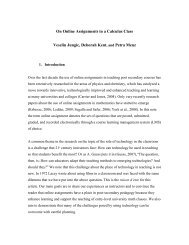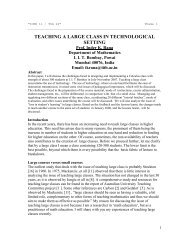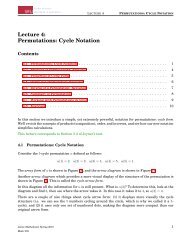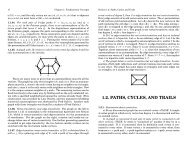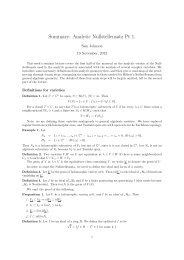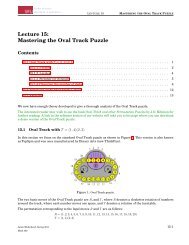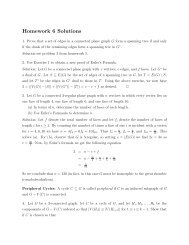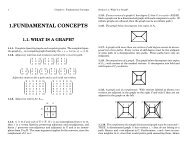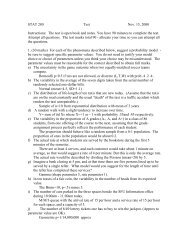Midterm - People.stat.sfu.ca - Simon Fraser University
Midterm - People.stat.sfu.ca - Simon Fraser University
Midterm - People.stat.sfu.ca - Simon Fraser University
You also want an ePaper? Increase the reach of your titles
YUMPU automatically turns print PDFs into web optimized ePapers that Google loves.
SIMON FRASER UNIVERSITY<br />
DEPARTMENT OF MATHEMATICS<br />
<strong>Midterm</strong><br />
Math 447/747 Fall 2012<br />
Instructor: Dr. Yeats<br />
October 12, 2012<br />
Name: (please print)<br />
family name given name<br />
SFU email: @<strong>sfu</strong>.<strong>ca</strong><br />
SFU-email<br />
Signature:<br />
Instructions:<br />
(1) Fill in your information above.<br />
(2) Students taking 447 should complete any 5 questions. Students<br />
taking 747 should complete any 6 questions. Please indi<strong>ca</strong>te which<br />
questions you would like marked:<br />
If you do not indi<strong>ca</strong>te anything the first answered ones will be marked.<br />
(3) Answer in the spaces provided; use the back if necessary. Justify your answers.<br />
(4) No <strong>ca</strong>lculators, books, papers, or electronic devices shall be within the reach<br />
of a student during the examination.<br />
(5) During the examination, communi<strong>ca</strong>ting with, or deliberately exposing<br />
written papers to the view of, other examinees is forbidden.
(1) (6 points) Prove algebrai<strong>ca</strong>lly that if C is an [n, M]-codeover the alphabet A with<br />
distance d = 2e + 1 then C <strong>ca</strong>n correct e errors.<br />
1
(2) (6 points) Let C be an (n, k)-code with distance d. Let w(C) be the Hamming<br />
weight of the code. Prove that d = w(C).<br />
2
(3) Let C be the binary linear code with parity check matrix<br />
⎡<br />
⎤<br />
1 1 0 0 1<br />
H = ⎣0 0 1 1 1⎦<br />
1 0 1 0 0<br />
(a) (2 points) What is the distance of C? Justify.<br />
(b) (1 point) How many codewords does C have?<br />
(c) (2 points) Give a generator matrix for this code.<br />
(d) (1 point) Encode the following message words<br />
(1 1) (0 1)<br />
3
(4) (a) (2 points) Give a parity check matrix for the binary Hamming code of order 3.<br />
(b) (2 points) Decode the following received vectors<br />
(1 0 1 1 0 1 1) (0 0 1 0 0 0 0)<br />
(c) (2 points) Is your answer the only possible correct answer for part (a)? part<br />
(b)? Explain.<br />
4
(5) Let C be the binary linear code with generator matrix<br />
<br />
1 0 1 0 1<br />
G =<br />
0 1 0 1 1<br />
(a) (4 points) Use any of the decoding algorithms in class to decode the following<br />
received vectors (use the next page if you run out of space)<br />
(1 1 1 0 1), (1 0 1 1 0), (0 1 0 1 1), (0 1 1 1 1), (0 1 0 0 0)<br />
(b) (2 points) Suppose the message encoding was<br />
O ↦→ 00 H ↦→ 10 L ↦→ 01 E ↦→ 11<br />
What is the received message from the previous part?<br />
5
extra space if useful for the previous question<br />
6
(6) (4 points) Prove that in an (n, k)-code with distance d we must have<br />
d ≤ n − k + 1.<br />
(2 points) Give an example of a code which is perfect and has d = n − k + 1.<br />
7
(7) (6 points) Prove that an (n, k)-code C is self-dual if and only if n = 2k and C ⊆ C ⊥ .<br />
8



